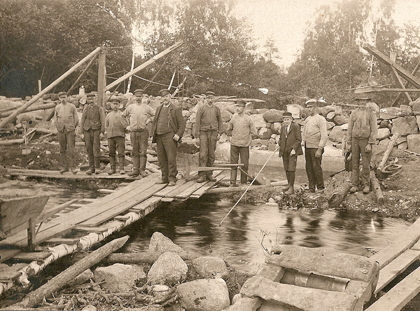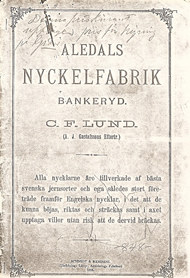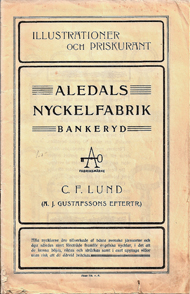On the death of Anders Johan in 1892, Aledals Nyckelfabrik was taken over by Carl Fritjof Lund, one of his brothers-in-law. Carl Fritjof was born in 1851 in Eskilstuna, and at 25 went to sea as a machinist. He married Katarina Susanna (Sanna) Gustavsson in 1879, and came ashore for good a few years later. They had two children, Karin and John.
Production under Carl Fritjof
Carl Fritjof started at Aledal by re-widening the dam and expanding the business. He concentrated on drop-forging key blanks and finished keys. He also continued manufacturing bicycle parts and steel combs. It was also a lucrative business to manufacture and supply meat grinder blades for Husqvarna and Bolinders in Eskilstuna. Production continued up until 1918.
 |
| Carl Fritjof Lund (this side of the wheelbarrow) supervises the dam project in early 1909. His son John, wearing a tie and breeches, can be seen fishing. |
It is clear from the product catalogues that the future was drop-forged keys. The company made a couple of hundred key models, which gradually became more and more popular and lucrative. They were made mainly for various lock companies in Eskilstuna, but were also exported to neighboring countries. They were sold by the gross, the product range comprising key blanks for padlocks, cabinet and rim locks for storage buildings and tool sheds, chamber locks, spring-latch locks, outer door locks, safe locks and cylinder (patent) locks. There were also finished keys for lock systems using master keys.
The iron for the keys was ordered from Abrahamssons Järnaffär in Jönköping, and was delivered in rods, which were collected from Boxholm and transported by rail to a site close to Aledal.
During manufacture, these rods were cut in the eccentric presses into manageable lengths. One surface of the rods was heated in the forge until white hot and then stretched until flat in an eccentric press. The key was then drop-forged in two strikes. The hammer was controlled by a foot-pedal. The burring, which is to say the surplus material of about 1 mm in thickness, was removed in a trimming punch fitted with a trimming dye of the same shape as the key. The keys were then polished (during the night) first in a barrel of sawdust, then by oil and finally with leather. They were than packed onto rings of one hundred. Recesses for the wards were cut in the bits of the keys that were sold ready to use, and for certain models the stem was bored out. These keys were packed into boxes of a hundred.
 |
 |
| The company’s first product catalogue, 1896. |
The company’s product catalogue, 1919, with logo. |